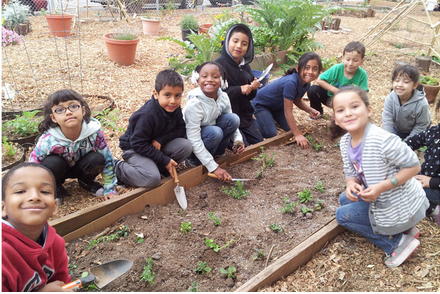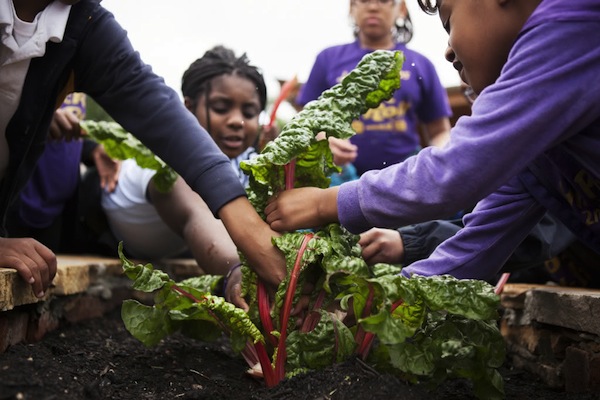A Reflection…
I think that my research into the importance of school gardens is best summed up by Veronica Gaylie, author of The Learning Garden “Learning in school gardens, students are not simply following a teacher directive or mastering a curriculum goal, but are breaking out by defining and redefining what learning in a local, shared place really means, based on their own unique experiences.”10 Throughout this project, I have read a lot of articles (see References page) that have discussed the variety of ways that school/community gardens are beneficial to students: development of community, improved nutrition habits, increased academic performance, physical activity, advancement of leadership and managerial skills.

Students in the Garden School Foundation garden http://gardenschoolfoundation.org/our-programs/
But then, the question I kept thinking about while I was searching for grassroots organizations was why aren’t there more schools with gardens? The majority of the organizations that I found were community gardens with school partnerships, or after-school/summer programs. The short answer: funding. School gardens are incredibly expensive to maintain and manage and as such, organizations often have their own gardens, and schools go to them. The students are still benefiting from these impressive gardens, but it is often supplemental as opposed to actively integrated into the school community.
As a result of high maintenance costs, and because funding is primarily linked with community affluence, the majority of school gardens are found in wealthy (usually white) school districts.5 Despite this, there are still many urban organizations (some of which I have listed in the Grassroots Organizations page) that have decided that the benefits of community gardens are worth the work needed to run them. Dedicated staff and volunteers manage the gardens and the programs because they have seen the benefits of having a community knowledgeable about food and nutrition. The most successful gardens are those that link this knowledge with means to increase food access and get students and families involved in growing their own gardens. Like Detroit Black Community Food Security Network, gardens that tackle food deserts and food access as well as teaching people about nutritious and healthy food sources can be the most meaningful in communities
I have also seen how urban schools that partner with community gardens or have ones of their own get students excited and enthusiastic about learning. In the process of learning and working outside, students get to see their hard work and dedication in real time as they watch their fruits and vegetables grow. Because students are active and outside, as opposed to sitting in walled classrooms, they are more engaged. While digging around in the dirt, learning becomes more than school, it become a part of life. Garden-based learning incorporates reading, science, history, and math in a way that learning becomes holistic and comprehensive. And importantly, because these gardens are a result of everyone’s work, the garden becomes a source of collaboration and community development. **As Kay Lawrence saw in her class, students helped others who were having a hard time understanding the teaching (whether because of language barriers or other difficulties) but also students from different cultures were able to help others understand their own culturally significant fruits/vegetables.** The garden thus becomes a cross-cultural space where ideas and information are shared, not just between teacher and student, but amongst the students themselves.
Some of these grassroots organizations also have summer internships where high school students learn a variety of important skills, and get paid while doing so. These students are able to learn gardening skills, leadership skills (when directing others in the garden), business and marketing skills (when they take their products to farmers markets), and monetary skills (when learn how to manage money from the profits of these farmers markets). These students are given tremendous amounts of responsibility, which incites them to rise to the occasion. This sets the students up for the future, and gives them the confidence to go on in later life knowing that they are successful with their toolbox of skills.
So what about my initial question. Do school/community gardens connect students to nature in the concrete jungle? The short answer is yes. A lot of the readings that I have done indicate that school gardens give students a sense of place connected to the land and a deeper understanding of natural processes.6 This increased environmental awareness is important for students who might have otherwise spent the majority of their lives surrounded by concrete and glass. These gardens give kids an opportunity to feel a physical connection with their environment by getting dirt under their nails. They get to experience the interconnectedness and interdependence of humans and nature.
The garden also becomes a place of shared community, as I have discussed above. Like how we, lucky enough to be at Bowdoin, bond over shared experience of the close proximity of the ocean, or the short drive away to hiking mountains, students in classrooms have the shared experience of working together in this garden. And isn’t that was grassroots organizing is about? Bringing people together? I would say that this shared experience brings students as well as community members, closer together under a common cause of food (and who doesn’t love food?).

Jones Valley Teaching Farm photo from https://news.wbhm.org/feature/2014/sustainability-grant-brigham-of-jones-valley-teaching-farm/
